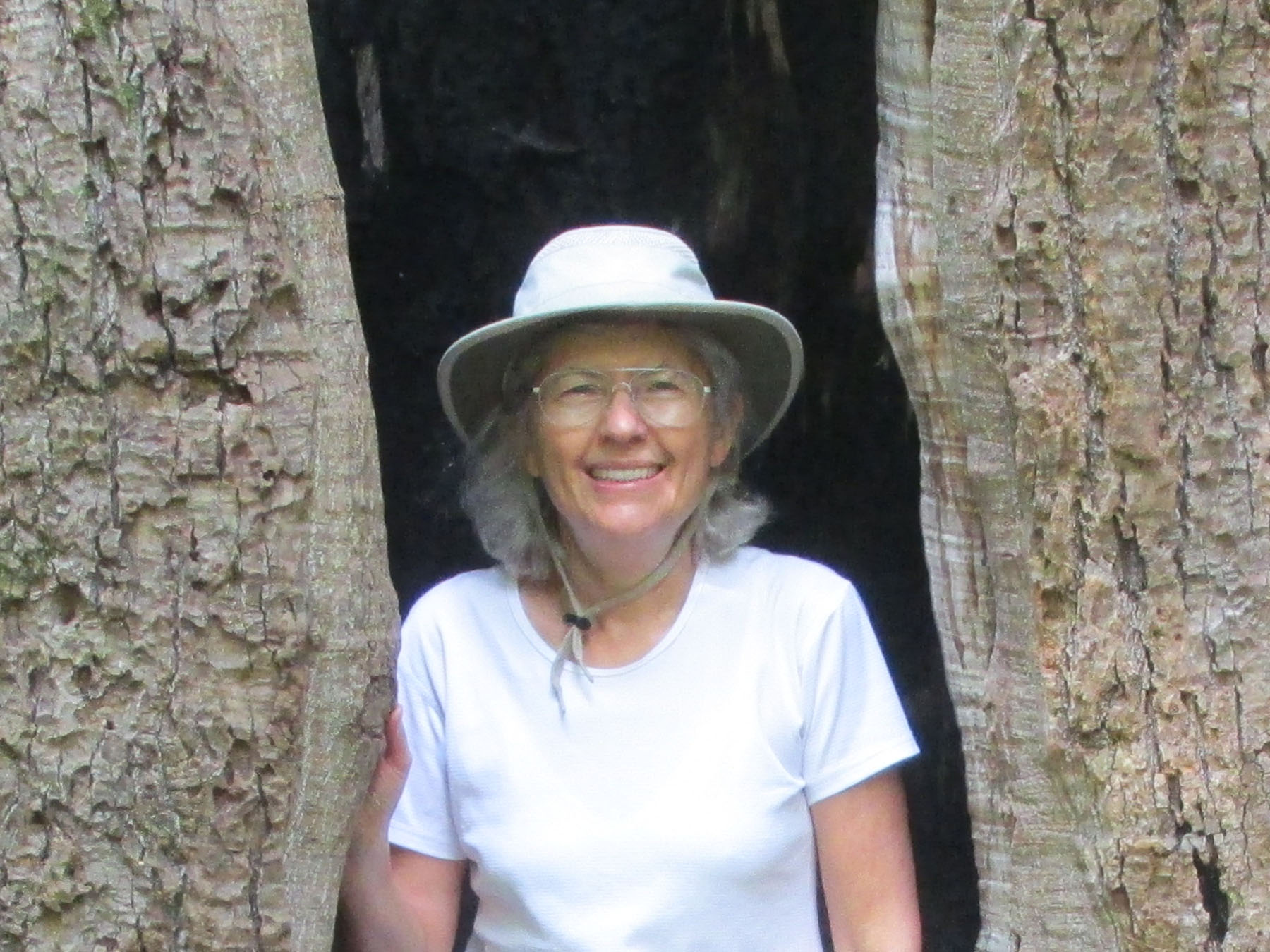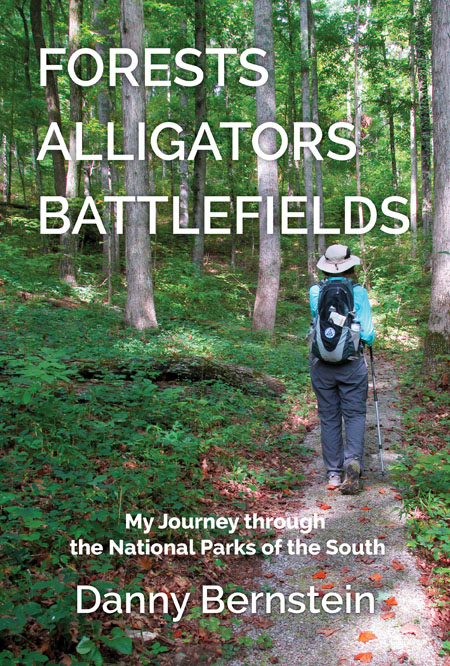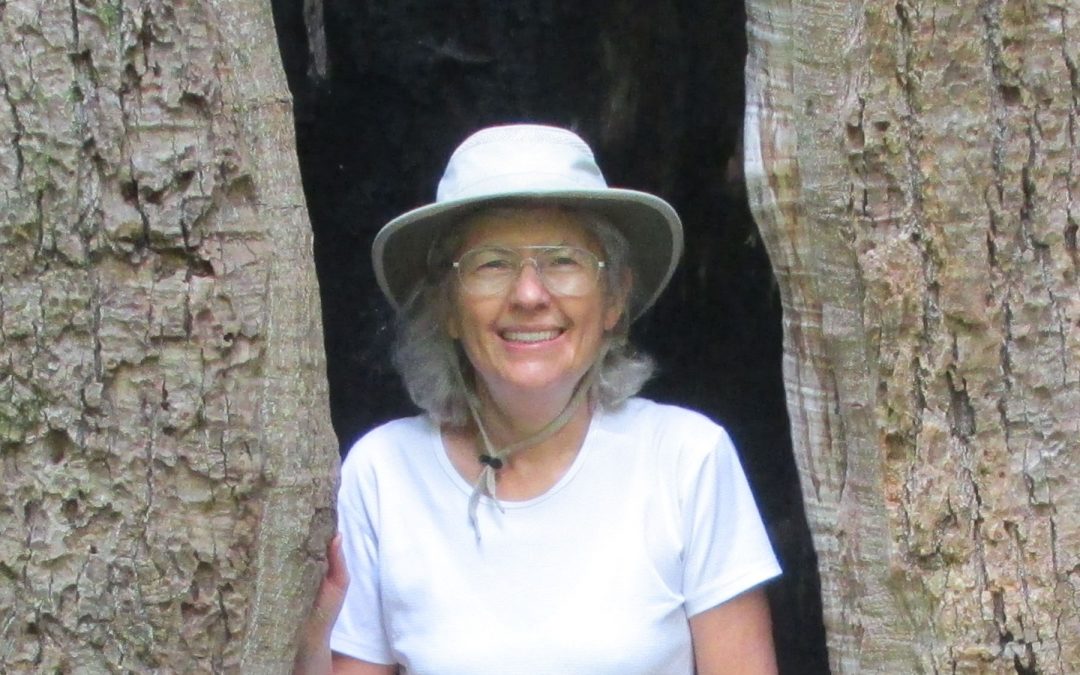
No place is too far to walk if you have the time – Danny Bernstein
For much of her adult life, New Jersey native Danny Bernstein was focused primarily on using her skills to develop software in the burgeoning computer industry. She later taught it as well. But all that time time in an office never dimmed her love for the outdoors. After she and her husband moved to North Carolina, she began writing books about the great hiking to be found in her adopted state. Earlier this year, she also celebrated the 100th anniversary of the National Parks System by releasing her latest work: “Forests, Alligators, Battlefields: My Journey through the National Parks of the South.” She was kind enough recently to share some time with me to talk about that book and her love of what renowned author and historian Wallace Stegner called America’s best idea.
The Open Mic: What got you inspired to do the kind of writing you do and to focus on the parks and hiking and nature?
Bernstein: I was raised in Brooklyn, nowhere near that one tree. You know “A Tree Grows in Brooklyn?” So I hardly had an outdoor childhood. But my husband and I started our work life in New Jersey, where we discovered hiking. We didn’t even know that adults hiked without children. That was great. So we joined a hiking club and went out on a regular basis. That was over 40 years ago and we have been not only hikers since then but hiking club people, because you can learn so much from other people. Now I am a hike leader for Carolina Mountain Club in Asheville, and Friends of the Smokies and basically any group that wants a volunteer leader. I call them my day job. In my previous life I was in computer science way before computing was cool. Essentially you realize that you can’t actually make a living writing guide books, so I was lucky to be able to publish two outdoor guides, which you can see on my website, with a small publishing company. I walk the Mountain to Sea Trail, which is our North Carolina trail through the state, and wrote a travel narrative. And while I was doing that I was visiting national parks regionally. I’ve been to the big ones, the real macho ones, what I call the why Y’s –Yosemite, Yellowstone, etc. But those to me are once-in-a-lifetime parks unless you live very close. But I lived within 45 minutes of the most visited national park in the country, the Great Smoky Mountains National Park so I started visiting the smaller parks. We lived almost within walking distance of the Blue Ridge Parkway, so I started looking at the smaller parks. The national historic homes, the battlefields, the memorials. I used to write for a website you may have known, National Parks Traveler, and it kind of kept me honest. I really had to dig in. It wasn’t just come in, see the movie, get my passport signed and go home. And then I found out that this year was the 100th anniversary of the national parks service, and it clicked. Instead of doing 59 national parks, and some people are doing that, why not concentrate on where I am in the south and become a southerner one national park at a time. And that’s what I’ve been doing for the past few years. I do a lot of other things, volunteer work, but I’ve been concentrating on visiting, learning and writing about the national parks in the south.
The Open Mic: What’s your process for trying to convey the flavor of each of these parks and bringing your readers along that journey with you?
Bernstein: First of all, I’m not National Geographic. So I don’t say ‘here are the hours for Park A and Park B, here’s the website.’ It is my journey. So let’s take a park which is not the top of pops. Let’s take Andersonville National Historic Site, which is a park in the middle of Georgia that protects the Confederate prison that held Union soldiers during the Civil War. It was a horrible place. So how do I get it? First, I read the official website cover to cover to find out why, to start, this place was protected. Then when I go there, I don’t care how small the park is, I plan to spend the day. I can’t deal with more than one park at a time in my head. So I go to the visitor’s center, get there at 9:00 and chat with the ranger. No matter how busy the park is, if you get there when they open, you will have the ranger’s or volunteer’s full attention. I do the movie or other tourist stuff, but then I go out and walk it. Andersonville for example, they have a tour, but I can’t deal with being in the car and stopping and coming out and stopping. I’m a hiker, so I walk, read the monuments and do that part of it. That generates a lot more questions, so I go back to the visitor’s center and by then there’s another ranger on duty, and by then there’s a long line. But it’s amazing how well you can engage a ranger. They are so enthusiastic, when you have questions other than ‘where’s the bathroom?’ After doing that particular park, I went to Andersonville National Cemetery which is just on the other side, where you see rows and rows of tombstones from the Civil War all the way to right now. The horrors of how soldiers lived in Andersonville was so much worse than the actual cemetery. The Southerner who was head of this prison didn’t have the facilities to care properly for the prisoners. His name was Captain Henry Wirz and at the end of the Civil War he was tried and hung for mistreating the prisoners. But he wasn’t from around here, as they say – he was from Switzerland. And many feel he was trapped by his orders from above and the lack of resources. So the southerners jumped on that angle, across the road there is a big memorial. By then it’s 5 o’clock and the place is closing. Sometimes I have to go back. I write my notes up and then I’ll do a blog post. I always try to start there because if I can’t blog, then I really don’t have a good story.
The Open Mic: When you sat down with all of the information you’d gathered, how did you pare it down to what ended up in “Forests, Alligators and Battlefields?” 
Bernstein: After visiting a bunch of parks, I realized that I wanted to organize things in a way that was meaningful to me. As you may know, every place in the East has been walked on. There is no real wilderness we know of. Maybe Northern Alaska where people haven’t been is untouched, but here the place that looks so wild as you get into the center of the Smokies or Big South Fork, has been touched. But still I want to separate out what I saw as the ‘nature parks,’ the great outdoors, from the historic and cultural parks, which is the bulk of what we have. So I took each park and looked at the date where whatever significant thing happened. If it’s a battle, you have a real date. If it’s something like the Wright Brothers, I guess you have a date there too. But anyway, I put all the cultural and historic parks in date order. So the way I’m organizing the book, you have all the Revolutionary War parks together, all the Civil War parks, the War of 1812, and I don’t really push history that much. It’s got to be enough for me to tell people why this is important. And I certainly don’t talk about the ‘blues stood there, and the gray stood there.’ It’s enough to say who won and talk about my journey. A lot of my journey is talking to the people now, the rangers, the volunteers, the park partners and the visitors.
The Open Mic: I understand you self-published the new book, whereas with your first books you went through traditional publishers. What was the impetus for you to self-publish? How was that process different than your previous book efforts?
Bernstein: Well, it was a lot more work. No matter how much I read up on independent publishing, I was not ready for how much work it is. Because this is a quality product, if I say so myself. I hired so many people, so much expertise. I had a historian check all of my facts. A developmental editor who sees if the story makes sense, a designer so that you wouldn’t be able to tell that this was self-published. I did talk to my old publishers who I had a wonderful experience with, and hopefully vice verse, and they felt that given their mission, the geographic area was too wide. Because let’s face it, for publishers in the end it’s all about selling books, which is fine with me. And to me, it’s all about marketing. I love to market. I’m talking to you. I love this, because I’m not marketing myself. I’m marketing the parks or the hiking or the trails. But anyway, I started out feeling this was going to be my contribution to the centennial. I started out with, all I was going to do was get a few books out on each space and send it to each superintendent, which I’ve done. But as time went on, people said, well you’re putting all this work in, do a little bit of this, a little bit of that. So how is it different? It was an incredible amount of work and detail and, as far as I know, it’s not over. I don’t know what roadblocks I’m going it hit. One example, independent bookstores will not deal with books printed by Create Space, which is owned by Amazon. So I actually ended up having two printers. One, Create Space, for you to buy the book on Amazon. And two, IngramSpark so that the bookstores can order my book.
The Open Mic: Has that proven problematic for getting stores to carry it?
Bernstein: Yes. There are bookstores in the area that just said ‘no, we only deal with established publishers.’ So yes. But I also go to a lot of hiking clubs, a lot of actual parks where they don’t care where the books are coming from. In terms of traditional bookstores, yes, the larger ones have said, ‘we’re just not interested.’ So I’ve been turned down.
The Open Mic: How do you handle rejection? How do you feel about the business end of all of this? Would you do another self-published book or would you go back to traditional publishing?
Bernstein: I think if I had pushed and pushed and pushed and didn’t care when the book came out, I probably could have found a traditional publisher. Not a big one, but a traditional publisher. But I had a real deadline that I felt was really important. As far as how I handle rejection, it’s an interesting question, because I just thought of this. I was in computer science way before computing was cool. I worked for large companies. The world needs computing people so I never had to sell myself. Or if I had to sell myself, I was bored very quickly, because I had traditional qualifications, and there was a real need for what I did. Now I’m learning, everybody wants to write books. It’s a completely different field that I’m in. Of course I use computing for my website and stuff like that, and in a way I use my skills by using GPS and the way I organize things. But it’s very different from always being in demand. Now I have to say, ‘get over it Danny. You’re in a competitive field where there’s a lot more supply than there is demand.’ That’s why so many people are self-publishing now. Would I do self-publish again? It’s like asking a pregnant woman, when are you going to have another baby? I want to see how this plays out, and by this I mean this book tour. I have had a lot of regional publicity, regional being Ashville and western North Carolina, because I know people from my last tour. But it’s harder to do things like getting on a radio program than I was able to get with my traditional publicist. Rowe Copeland is very good, but she’s not representing the industry press, which was my last book. She’s representing me. I did technically start a publishing company, just so I could put the name on it. It’s called Kimberly Crest books. But realistically, I’m not a publishing company. So you have to let it roll off your back or else you’ll go nuts.
The Open Mic: Have you thought about the next parks you want to visit or showcase?
Bernstein: I keep a list. There’s 410 park units in the country, and I think I’ve done 150. If I ever think of doing something like this again, it would not be in the West. It would be in the upper Midwest, which is an area that I’ve been to that’s kind of forgotten in terms of the whole country. I would love to go to Voyageurs, Teddy Roosevelt, Pictured Rocks, and obviously all of the parks on the way. See, that’s all exciting, but if I’d said Alaska you would have been thrilled. But every place has exciting, beautiful areas to explore. What’s problematic about getting out of my own area is the marketing. Where now I have more and more contacts and places have my book events, in the Midwest I would start completely from scratch. California too. Who is she? For all I know, people have done this in the Midwest.
Learn more about Danny and purchase her books on her website, Hiker to Hiker.

